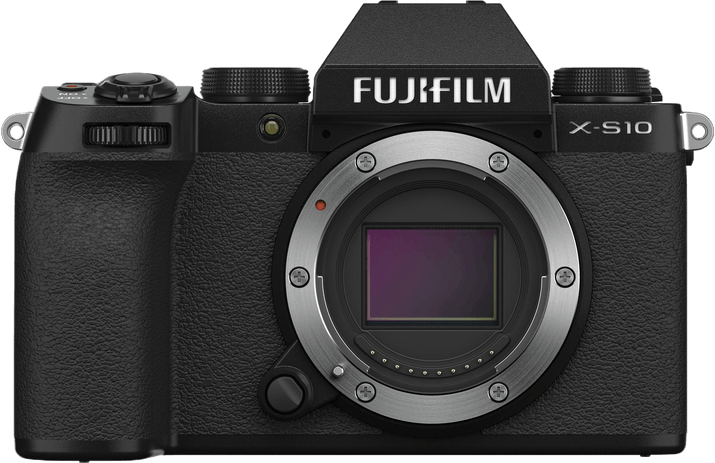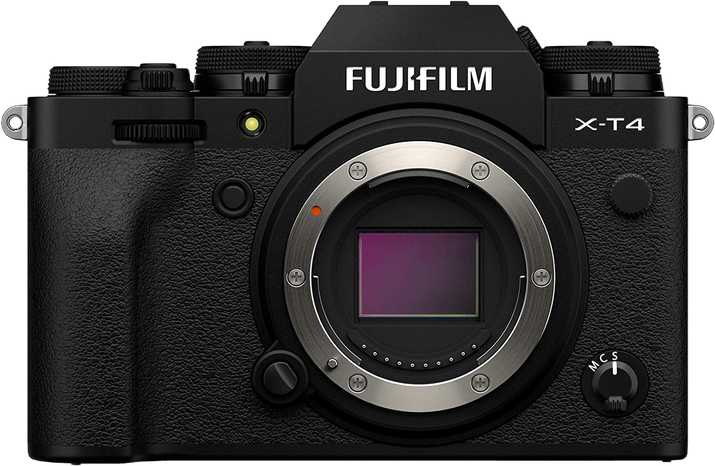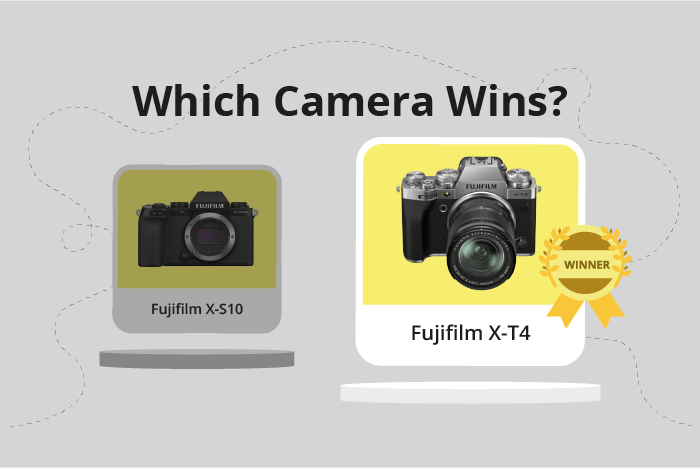Fujifilm X-S10 vs X-T4 Comparison
Fujifilm X-S10

Fujifilm X-T4

The Fujifilm X-T4 takes the lead with a score of 76/100, while the Fujifilm X-S10 trails behind at 69/100. Both cameras are mirrorless and were released in 2020, sharing some similarities. The X-T4 excels with a higher score due to its superior performance and features. However, the X-S10 has its advantages, such as a lower launch price of $999 compared to the X-T4’s $1699, making it more budget-friendly. Additionally, the X-S10 is lighter at 465g and smaller with dimensions of 126 x 85 x 65mm, giving it a more compact and portable design.
Taking into account these specifications, the Fujifilm X-T4 is the better camera for those seeking top-notch performance and features, while the Fujifilm X-S10 is a more affordable and portable option for casual photographers.
Fujifilm X-S10 vs X-T4 Overview and Optics
The Fujifilm X-T4 outperforms the Fujifilm X-S10 in optics, scoring 73/100 compared to the X-S10’s 72/100. Both cameras share several specifications, including 26 megapixels, a 20 fps shooting speed, a CMOS sensor, the X-Processor 4, an APS-C sensor size, a Fujifilm X lens mount, and image stabilization.
The X-T4’s slight advantage in optics stems from its superior build quality and weather resistance, which allows for better performance in various shooting conditions. This feature ensures that the X-T4 can withstand challenging environments, providing more reliable and consistent image quality.
On the other hand, the X-S10 has a more compact and lightweight design, making it easier to carry and handle. This could be an advantage for photographers who prioritize portability and ease of use over the X-T4’s improved build quality and weather resistance.
In terms of optics, both cameras are quite similar and offer excellent image quality. The X-T4’s edge in build quality and weather resistance makes it a better choice for photographers who require a more robust camera for challenging conditions. However, the X-S10’s compact design may appeal to those who value portability and ease of use.
Choosing between the Fujifilm X-S10 and X-T4 ultimately depends on the individual photographer’s needs and preferences. The X-T4’s superior build quality and weather resistance make it a more versatile option, while the X-S10’s compact design offers greater convenience for those who prioritize portability.
Fujifilm X-S10 vs X-T4 Video Performance
The Fujifilm X-S10 and Fujifilm X-T4 both receive a video score of 91/100, indicating a tie in video capabilities. They share common specifications, including a maximum video resolution of 4K and maximum video dimensions of 4096 x 2160. Both cameras also have built-in time-lapse functionality.
The Fujifilm X-S10 edges ahead with a maximum video frame rate of 240fps, double that of the X-T4’s 120fps. This higher frame rate allows for smoother slow-motion video capture and improved action footage, making the X-S10 a better option for those who prioritize high frame rate video.
On the other hand, the Fujifilm X-T4 does not surpass the X-S10 in any video-related specifications. However, it is essential to consider other factors, such as the camera’s overall performance, build quality, and additional features, to determine which camera is better suited for a user’s specific needs.
Both the Fujifilm X-S10 and X-T4 offer impressive video capabilities, with the X-S10 providing superior slow-motion and action footage due to its higher maximum frame rate. Although the X-T4 does not excel in video compared to the X-S10, it remains a strong contender for those looking for a well-rounded camera. Ultimately, the choice between these two cameras depends on the user’s priorities and preferences.
Fujifilm X-S10 vs X-T4 Features and Benefits
The Fujifilm X-T4 emerges as the winner in the features comparison with a score of 85/100, while the Fujifilm X-S10 scores 70/100. Both cameras share some common specifications, including a 3-inch screen size, touchscreen capability, flip screen, and Bluetooth connectivity. However, the X-T4 outperforms the X-S10 in certain aspects, and the X-S10 has its own advantages as well.
The Fujifilm X-T4 has a higher screen resolution of 1,620,000 dots compared to the X-S10’s 1,040,000 dots. This results in a sharper and clearer display on the X-T4, allowing for better image review and composition. Moreover, the X-T4 comes with Wi-Fi connectivity, which is absent in the X-S10. This feature enables easier file transfer and remote camera control through a smart device.
On the other hand, the Fujifilm X-S10 has its own strengths despite its lower feature score. It is generally more affordable and compact than the X-T4, making it a suitable option for those seeking a lightweight and budget-friendly camera. However, it lacks Wi-Fi connectivity, which may not be a significant drawback for users who prioritize other aspects over wireless capabilities.
Taking the above points into consideration, the Fujifilm X-T4 offers better features with its higher screen resolution and Wi-Fi connectivity. These enhancements contribute to its higher feature score and overall superiority in terms of performance. However, the Fujifilm X-S10 remains a viable alternative for those who prefer a more compact and affordable camera without compromising too much on essential features.
Fujifilm X-S10 vs X-T4 Storage and Battery
The Fujifilm X-T4 outperforms the X-S10 in storage and battery, scoring 73/100 compared to the X-S10’s 35/100. Both cameras accept SD, SDHC, and SDXC memory cards and offer USB charging. However, the X-T4 is superior with its two memory card slots and UHS-II compatibility, while the X-S10 has only one slot with UHS-I compatibility.
Additionally, the X-T4 boasts a longer battery life, providing 500 shots per charge with its NP-W235 battery, compared to the X-S10’s 325 shots using an NP-126S battery. The X-S10 does not offer any advantages in this category.
Given these differences, the X-T4 is the clear winner in terms of storage and battery capabilities, offering more convenience and flexibility for photographers.
Alternatives to the Fujifilm X-S10 and X-T4
Are you still undecided about which camera is right for you? Have a look at these popular comparisons that feature the Fujifilm X-S10 or the Fujifilm X-T4:

